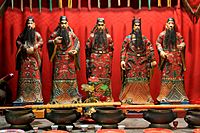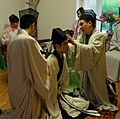Chinese folk religion facts for kids


Chinese folk religion (Chinese: 中国 民间 信仰 (simplified spelling) or 中國 民間 信仰 (traditional spelling), zhōng-guó mín-jiān xìn-yǎng) is a religion that has been practiced in China, and in areas inhabited by Chinese people. It is difficult to make a clear distinction between Chinese folk religion and other beliefs, because Chinese folk religion has elements of veneration of the dead, local spirits, clan spirits and traditional Eastern religions, such as Taoism, Confucianism, Buddhism, but also superstition, geomancy and Feng shui. There is no standarized mythology or clergy: rites are often performed by the father of a family. Since the 1950s, Chinese folk-religion is also sometimes refered to as Shenism or Shénism (Chinese: Shén-jiào, 神教),. In this context, shen refers to a spirit or a deity. The term Shenism was first used by A. J. A Elliot in 1955. The term Chinese folk religion is not used inside China.
Sometimes, it is classified with Taoism: Over the centuries, Taoism became institutionalised. During that time, it tried to use local customs, and to become similar to local religions and beliefs. It would however be more accurate to say that Taoism developed from Shenism, since Shenism was there before. Taoism also developed from Chinese philosophy. With around 454 million adherents, or about 6.6% of the world population, Chinese folk religion is one of the major religious traditions in the world. In China more than 30% of the population adheres to Shenism or Taoism.
During the last 200 years, religion has been heavily suppressed in China, with rebellions such as the Taiping Movement or Cultural Revolution. Today, Chinese folk religion is experiencing a major revival in both Mainland China and Taiwan.
The government of Mainland China has officially supported different forms of Shenism, such as Mazuism in Southern China (officially about 160 million Chinese are Mazuists), Huangdi worship, Black Dragon worship in Shaanxi, and Caishen worship.
Images for kids
-
Xuanyuan Temple in Huangling, Shaanxi, dedicated to the worship of the Yellow Emperor.
-
The Temple of the City God of Wenao, Magong, Taiwan.
-
Temple of Hebo ("River Lord"), the god (Heshen, "River god") of the sacred Yellow River, in Hequ, Xinzhou, Shanxi.
-
A sign reading "This is a place of folk belief. No religious donation or religious activities are allowed." Taken in a Chinese folk temple in Weifang City, Shandong Province
-
Eastern Han (25–220 AD) Chinese stone-carved que pillar gates of Dingfang, Zhong County, Chongqing that once belonged to a temple dedicated to the Warring States era general Ba Manzi
-
A shrine dedicated to Zhenwu in Wuqi, Taichung, Taiwan.
-
People gather for a worship ceremony at an ancestral shrine in Hong'an, Hubei.
-
Temple of the White Sulde of Genghis Khan in the town of Uxin in Inner Mongolia, in the Mu Us Desert. The worship of Genghis is shared by Chinese and Mongolian folk religion.
-
Temple of Fortune and Longevity, at the Heavenly Lake of Tianshan in Fukang, Changji, Xinjiang. It is an example of Taoist temple which hosts various chapels dedicated to popular gods.
-
Main altar and statue of Doumu inside the Temple of Doumu in Butterworth, Penang, Malaysia.
-
Statue and ceremonial complex of the Yellow and Red Gods, from whom the Han Chinese are said to be the descendants, in Zhengzhou, Henan.
-
Shrine of Bixia at Mount Tai, Shandong.
-
Vows to a deity at a Chinese temple in Vietnam.
-
A Taoist rite for ancestor worship at the Xiao ancestral temple of Chaoyang, Shantou, Guangdong.
-
Guan Li, Confucian coming of age ceremony.
-
Gathering at a Temple of the City God of Guangzhou, Guangdong.
-
Folk temple on the rooftop of a commercial building in the city of Wenzhou.
-
Temple of Mazu in Yokohama, serving the Chinese of Japan.
See also
 In Spanish: Religión tradicional china para niños
In Spanish: Religión tradicional china para niños





































